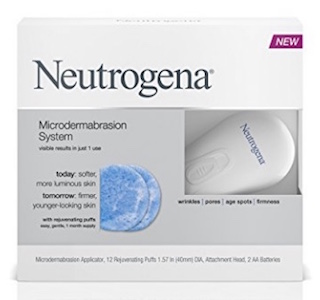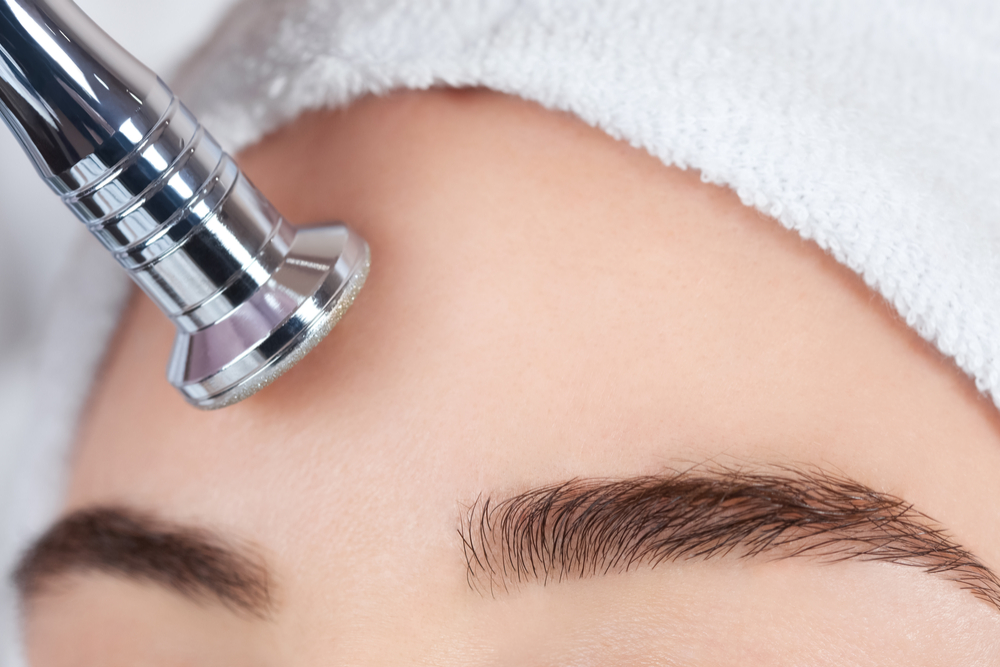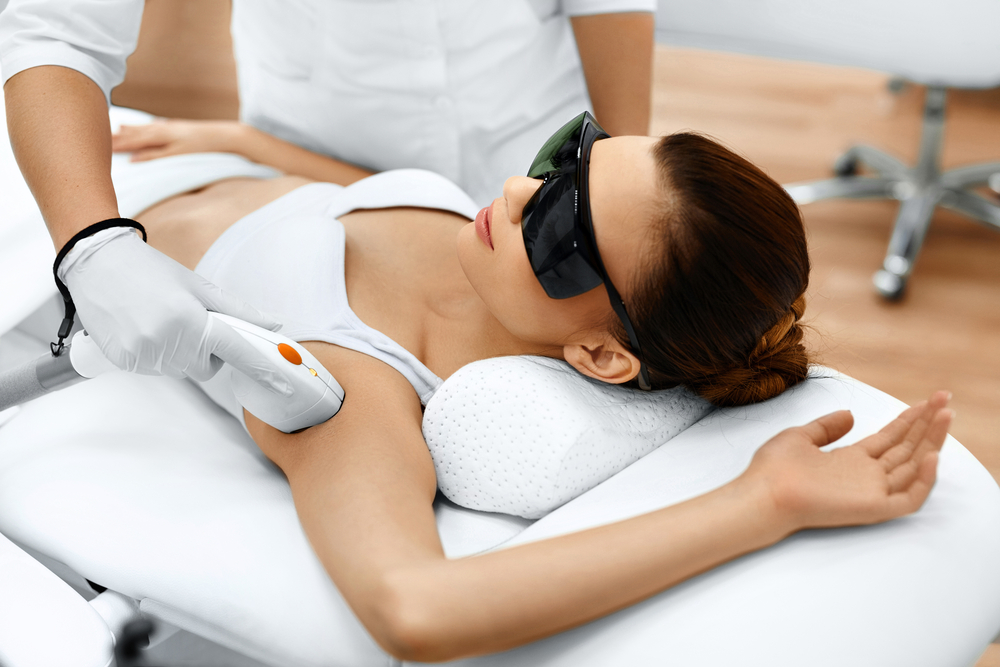- Microdermabrasion is a painless procedure with minimal risk that removes dead cells at the skin’s surface.
- Medical spas and clinics are no longer the sole domain for microdermabrasion.
- Affordable creams and machines can be bought and used at home.
What is microdermabrasion?
Microdermabrasion is used to reduce the appearance of fine lines, mild sun blemishes, age spots or shallow acne marks. It’s typically applied to the face, although the treatment can be used anywhere on the body, including the neck, hands, chest or back.
This popular skin rejuvenation technique employs tiny crystal granules of white aluminum oxide that come in various geometric shapes, with lots of corners and edges to gently abrade the top layer of skin.
Note that microdermabrasion should not be confused with dermabrasion, an invasive surgical procedure for deep wrinkles or acne scars that is generally performed under anesthesia.
There are basically two formats of at-home microdermabrasion: creams and machines. Both use tiny crystals to polish the skin and can be found in larger pharmacies, big national retailers like Target and Wal-Mart, or can be purchased online from Amazon.
DIY microdermabrasion scrubs and creams
Most microdermabrasion creams on the market – ranging anywhere from $10 to $100+ USD – are formulated for use on the face, meaning they’re gentler than body creams, which should not be applied to the face or other delicate areas.
The crystal-laden creams differ from regular scrubs and exfoliating creams that usually contain fine sand, salt or sugar crystals.
There are so many different kinds of microdermabrasion creams, serums and lotions on the market. It’s vital to read the ingredient list carefully as some of them may contain chemical peel products that may not be suitable for people with sensitive skin.
Go with what you know
Since so many popular beauty brands feature their own version of microdermabrasion creams, it’s perhaps best to go with a brand you trust and check the product reviews.
Mary Kay has the TimeWise Microdermabrasion Set, which comes with a scrub to “refine” and a serum to “replenish.” Olay is another brand that offers their take on this DIY home procedure with their Olay Regenerist Kit, which comes with a scrub and a peel serum to use in combination for “brighter, softer skin.”
The Mary Kay cream and the one by Olay have similar ratings on Amazon, although the Olay product has been reviewed by far more consumers.
Already have a cleanser that works well for your skin? No problem. You can even add microdermabrasion crystals to your favorite facial cream.
Simply purchase a jar of NeedCrystals Microdermabrasion Crystals, which contains very fine granules of white aluminum oxide. These granules are smaller than table salt and can be mixed in to transform any cleanser into a microdermabrasion treatment.
At-home microdermabrasion machines
In the last few years, more affordable home microdermabrasion machines have become readily available online and in stores, retailing anywhere from $100 to $300 USD.
These machines work a little like a combination leaf blower, electric sander and vacuum specially designed for the skin.
A typical crystal microdermabrasion system has four parts:
- A hand piece to easily maneuver the microdermabrasion tool
- A tube to connect it to the machine – although cordless handheld models are now being sold too
- A pump to blast a gentle high-pressure stream of tiny crystal particles over the skin
- A vacuum to remove the used crystals and exfoliated skin cells
There are a number of smaller and cheaper (under $50 USD) handheld options with rotating brush heads made by popular beauty brands like Neutrogena and Olay ProX. Of these, the Neutrogena model is rated the highest while the Olay machine has the most reviews.


Unfortunately, it’s possible for the fine crystal dust to wind up in the eyes or mouth, so another increasingly popular option is diamond microdermabrasion. Instead of a pump, the hand piece looks like a wand tipped with very tiny diamonds, which has earned this type of microdermabrasion the nickname “diamond peel.”
Top-of-the-line: Kendal vs. MicrodermMD
Among the higher end diamond peel models, there’s the Kendal Professional Diamond Microdermabrasion Machine, which features a diamond head and 3mm friction depth.

Another popular machine is the MicrodermMD, according to Erynn Guffey, Master Medical Aesthetician at Plastic Surgery Associates in McLean, Virginia. She says it “looks like a suitcase but doesn’t go over the top.”
The MicrodermMD device is a mini-version of the larger machines found at medical spas and clinics. It has an LED display, diamond tip wand and a 5X-magnification mirror. Guffey recommends it over the Kendal as she claims the latter is harsher and increases the risk of over-exfoliation.

At-home vs professional microdermabrasion treatments
Higher end at-home machines like the MicrodermMD and the Kendal Professional Diamond Microdermabrasion Machine are the real deal as they offer effective microdermabrasion at home.
However, according to Guffey, “The vacuum pressure doesn’t go up as high as a professional machine, so you get more in-depth treatments in the office, and a doctor or aesthetician can do more in combination with products.”
For instance, many of her clients choose to undergo a micropeel, which is a microdermabrasion followed by a chemical peel. The products can then reach further into the skin once the dead cells have been removed and better target fine lines, acne scars and blemishes.
How often should I microderm?
After experiencing results from polishing away those dead skin cells, it can be tempting to go overboard with the cream or machine versions of microdermabrasion.
Guffey cautions against this: “You don’t want to do microderm more than once a week. Over exfoliation does more harm than good.”
Too deep or too frequent microdermabrasion can cause redness, bruising, skin sensitivity, or trigger certain conditions like post-inflammatory hyperpigmentation. If you are using a machine at home, Guffey recommends that you undergo treatments no more than once a week at first, and then space that out to every 4-6 weeks.
After getting started, monthly maintenance sessions make sense as human skin usually regenerates every 30 days.
There are no specific age guidelines, but microdermabrasion at home or in the clinic is typically recommended for older teens and adults no more than age 70 years since very young and very old skin are more prone to irritation and bruising.
“I always caution people to use their best judgment, and remember — less is more,” Guffey says.
Takeaway
As technology for skin care becomes more readily available for anyone to purchase, it may be worthwhile to check in with a professional to get recommendations on what would work best for your skin type so you don’t cause more harm than good.
Guffey concurs, stressing that consulting a dermatologist or aesthetician before you start microdermabrasion at home can help you determine the best treatment plan and frequency for you.
» To find out which type of skin rejuvenation treatment is best suited to your needs, meet our medical review team.









